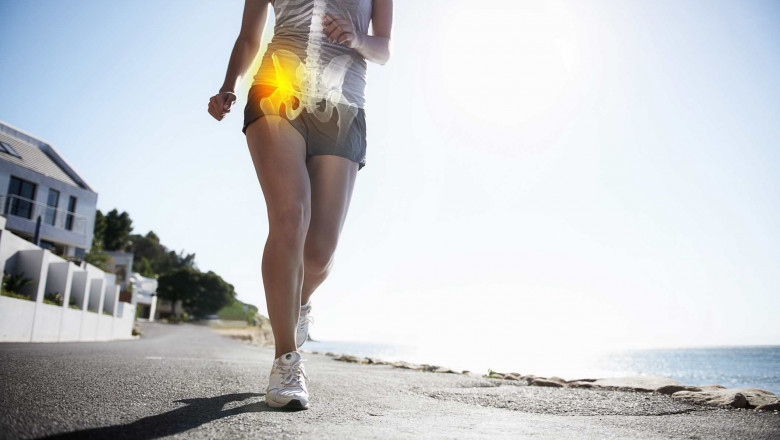views

The 6 Most Common Hip Pain Causes in Athletes
Most individuals commonly associate hip injuries with older folk. Hip injuries are typically caused by weakened muscles and bones that have lost their density and are more prevalent in the elderly and those with excess weight. However, hip pain can affect anyone, regardless of age or body type.
Compared to the elderly, hip injuries are much more likely to occur in athletes and other physically active individuals. Sports almost always force your body into unnatural positions or cause overextension. Serious injuries caused by fall bends, and other inappropriate muscle and tissue placement typically result in hip pain. Furthermore, athletes who overuse their hip joints and muscles may also feel more discomfort and pain.
Your best option is to recognize that you have damaged your hip. Hip injuries can quickly result in crippling pain, immobility, or irreversible damage, which can ruin any athletic career if ignored.
Read on to learn about the most common hip injuries related to sports.
1. Labral tear
The labrum is a cartilage rim that supports a ball and socket joint, particularly the ones in your hips and shoulders. This cartilage connects the two bones together and prevents them from grating against each other. It enables people to move easily and harmoniously while experiencing the least amount of pain. A labral tear happens when the labrum is torn or weakened. Your hip's ball and socket may move apart or fail to connect. Sometimes, labral tears cause a tissue fragment to get constricted and trapped inside the joint.
Acute soreness in the groin, thigh, or leg area is frequently one of the signs of a labral tear. There can be some stiffness or a popping sensation that makes movements less fluid. After spending a lot of time standing, sitting, or walking, you can also have hip or groin discomfort that is becoming worse.
The misuse of the hip muscle is the most frequent culprit behind labral tears. Sports that emphasize sprinting or rapid twisting and pivoting movements can accelerate the deterioration of joints. A tear may also develop as a result of a contact sports injury.
2. Iliopsoas Impingement and snapping hip
You most likely have iliopsoas impingement, also known as snapping hip syndrome, if you experience a kind of popping or cracking feeling in your hip when sitting, standing, walking, or swinging your leg. Your hip flexor sometimes referred to as the iliopsoas, joins your spine to your femur. You can walk, sit, and rotate your hip laterally because of this structure that runs down the front of the hip. In rare cases, the iliopsoas-related muscles and tendons tighten up and stiffen, which causes the tendon to "snap" across the labrum and cause a cracking sound.
An iliopsoas impingement is initially not a major concern by itself. Instead of being painful, the sensation could just be extremely irritating. However, if you choose to ignore it, repeated rubbing on the labrum can cause a labral tear.
A snapping feeling while moving or forcing the tendon to switch positions is the main sign of an iliopsoas impingement.
Engaging in strenuous exercises without enough stretching is the primary culprit of iliopsoas impingement. During demanding activity, the muscles tense and constrict the tendons. Prolonged bending and overextending can result in iliopsoas impingement, particularly in dancers.
3. Bursitis
There are fluid-filled sacs called bursae all across your body. They aid in reducing tension between bones, tendons, muscles, and ligaments. Inflammation of these sacs, known as bursitis, leaves them ineffective at minimizing any friction and pressure between the aforementioned structures. Your bones will grind against your muscles and tendons, irritating nerves and resulting in excruciating symptoms. Trochanteric bursitis, which affects the outside part of the hip, and iliopsoas bursitis, which affects the area close to the groin, are the two hip bursitis conditions that occur most frequently.
The stiffness and painful symptoms in your hips that exacerbate with movement or repetitive motions are typical signs of bursitis. Putting pressure directly on the hip or groin, lying down, climbing and descending stairs, and standing up from a seated posture will all cause pain.
The primary cause of bursitis is repetitive, intense strain on the hip joint from sports activities. When you exert a lot of pressure on your hip but quickly shift direction or pause, there is a larger possibility that you may develop bursitis. Soccer, football, hockey, and other comparable sports increase your chances of developing this injury.
4. Femoroacetabular impingement
A bone spur, also known as an osteophyte, can develop around the ball and socket joint, causing femoroacetabular impingement. Osteophytes are natural bone growths that result from the friction of one bone against another. Some of the structure is usually lost due to this friction. By repurposing an existing bone, your body strives to make up for the lost one. Any movement after the bone spur develops forces it to rub against the adjacent bone, muscle, or tendon. It can harm other structures or tear the labrum if left unaddressed.
Based on where a bone spur is in the hip, different symptoms may be present. Some people experience no discomfort or very little damage. Others may suffer incredibly intense pain that limits their ability to move their legs.
The advent of osteoarthritis is one of the most common causes of femoroacetabular impingement. When performing sports, poor posture can lead to strain and rubbing in the ball and socket joint. Your body may create a bone spur in an effort to mend a fractured bone in your hip.
5. Traumatic subluxation and dislocation
Traumatic subluxation and dislocation is a severe injuries that can result in long-term consequences. Damage that causes the femur to dislocate or shift away from the pelvic bone is what leads to hip traumatic subluxation and dislocation. The femur is often forced away from the joint by blunt force trauma, which is frequently seen in sports like football and hockey.
Some athletes experience permanent nerve, blood vessel, and ligament damage from the dislocation. If a diagnosis is made, the doctor could warrant surgical intervention to treat the problem. You also could require physical treatment, extended rest, and painkillers.
Traumatic hip subluxation and dislocation symptoms are comparable to those of other joint dislocations. Your injured joint will start to hurt more and more. Eventually, it can start to swell or bruise. In severe cases, the joint may completely stop moving, and you may also notice an obvious malformation around the joint.
The ball and socket joint can be forced out of the socket due to physical trauma. Falls and contact sports are two prominent causes of this injury in athletes. Weaker muscles and tendons around the joint increase the risk of dislocation.
6. Stress fracture
The pelvic bone is often involved with stress fractures of the hip. Stress fractures are characterized by hairline cracks along the bone. The fracture could progress and worsen if it is ignored. If identified timely, the best thing to do is to immobilize the affected limb until it fully heals.
You can have groin pain from a stress fracture when standing and moving, which could cause you to limp. Running, taking the stairs, or doing a lot of housework can all result in intense, debilitating pain that makes you quit what you're doing right away.
The most frequent causes of stress fractures are long-distance running and other running-intensive activities. Compression and microfractures in the hip and femur bone are caused by repeated tension. Athletes who struggle with eating disorders or other dietary imbalances are at greater risk.












